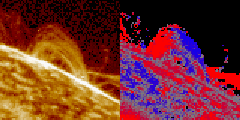
The UVSP, a joint project of the NASA Marshall and Goddard Space Flight Centers, consisted of an aplanatic Gregorian telescope of approximately 2" resolution, an Ebert-Fastie spectrometer, and five photomultiplier detectors (four CsI photocathode tubes for use below 1900 Å and one CsTe tube for use at longer wavelengths). The telescope secondary was mounted on gimbals and could be rastered to build up an image of an area on the Sun of up to 256" x 256", in steps of as little as 1". In a pivoting slit wheel were 22 combinations of entrance aperture and diametrically opposed exit slits (as many as five exit slits per aperture). The entrance apertures ranged in size from 1" x 1" to 125" x 286", and the exit slits ranged from 0.01 to 3.0 Å in second order.Several of the exit slits were biescted by beamsplitter prisms that could direct the short- and long-wavelength sides of a line profile to different detectors to allow velocity imaging ("Dopplergrams") of selected areas of the solar surface. A polarimeter could be inserted behind the exit aperture; it consisted of two systems: a three-quarter wave retarder for an effective linear polarizer, and a quarter-wave retarder and linear polarizer for use at wavelengths at which the grating polarization is very low. All instrument functions were controlled by a small, dedicated computer.
In April, 1985, the UVSP grating drive mechanism became stuck; efforts to release the obstruction were unsuccessful, and apparently led to the failure of a coupling in the drive in September, 1985. The grating appears to be fixed at a wavelength of about 1380 Å (second order; about 2760 Å in first order). During periods of solar activity, UVSP was used in second order to provide pointing and timing information for use in conjuction with other SMM instruments; at other times, first-order measurements of ozone concentration in the earth's atmosphere were carried out at spacecraft sunrise and sunset. These unique observations made possible a mapping of ozone concentrations of -50° to 50° at altitudes of 50-75 km.